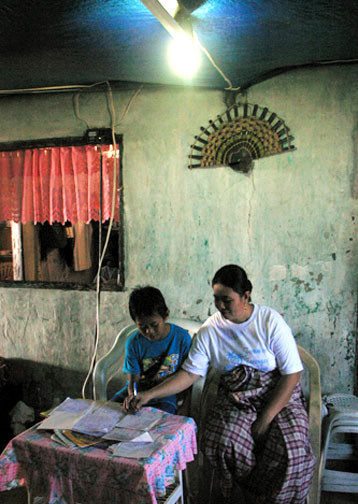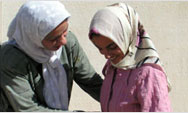You are here » Home » Telling Our Story
Success Story
Lighting homes and hearts in a conflict-affected area
Electricity Lights Up Communities

| |
Photo: USAID/Gil Nartea
|
|
In their newly electrified home in Tawi-Tawi, in the southern Philippines, Mrs. Arik helps her son do his homework at night with the help for fluorescent lighting.
“The project provided the light that brought us closer together,” said one local official in Mindanao.
|
The region of Mindanao in the southern Philippines is home to a number of communities struggling to rebuild after years of violent conflict. In rural Mindanao, access to electricity and the ability to turn on a light switch is a novelty. But, thanks to USAID, such things are becoming more and more common.
USAID is improving the quality of life in many Mindanao communities by enabling families and businesses to generate clean, renewable solar-powered electricity at an affordable price. Solar-battery energy systems provided by USAID, in partnership with the Philippine Department of Energy and private sector energy supplier, Mirant Philippines, have brought electricity to remote communities for the first time and helped cut expenses elsewhere.
In the province of Tawi-Tawi, the southernmost island in Mindanao, lighting bills for residential customers relying on USAID-provided renewable energy now average less than $6 a month, instead of $7.50 using kerosene lamps — a major difference for poor families in the region. Moreover, solar-powered energy is more environmentally friendly.
The benefits of clean electricity go beyond financial savings. In communities that USAID has helped electrify for the first time, fluorescent bulbs allow teachers to prepare for their classes and children to study after the sun sets. Adults can now keep making products they sell — like mats and nets — late into the evening. Streetlights make communities safer at night. One local official summarized the effect of affordable electricity by saying, “The [USAID] project provided the light that brought us closer together.”
As of July 2006, USAID has helped bring electricity to approximately 300 barangays, or villages, and more than 7,000 families in Mindanao. By delivering clean and affordable energy to rural communities, USAID is helping improve the quality of life for tens of thousands of residents in Mindanao.
Print-friendly version of this page (462kb - PDF)
Click here for high-res photo
Back to Top ^ | 

